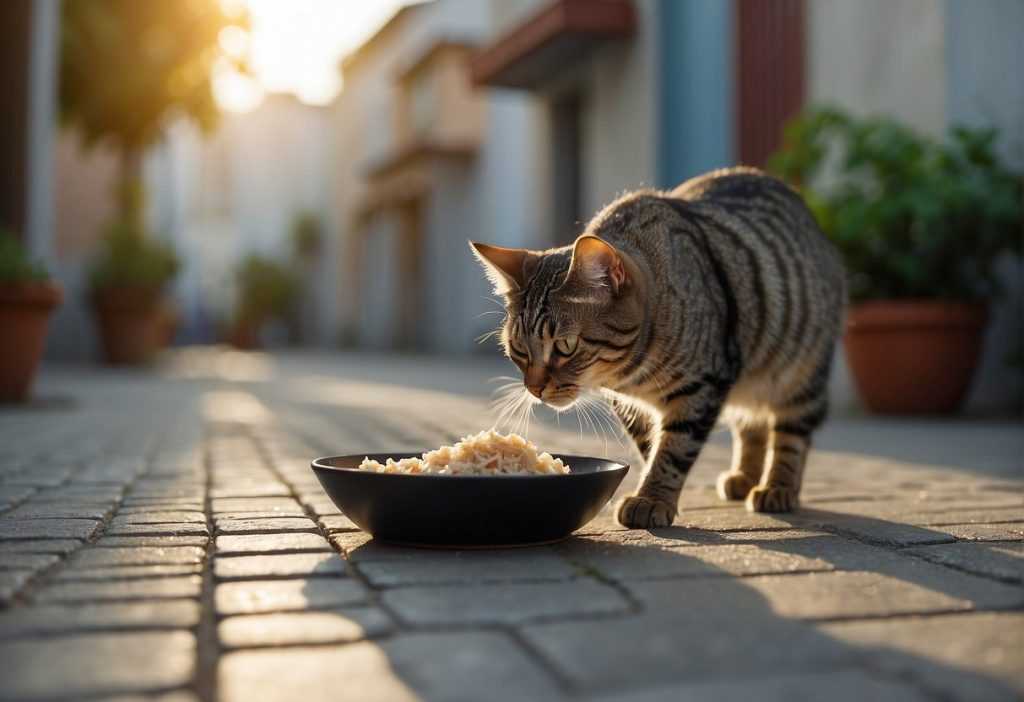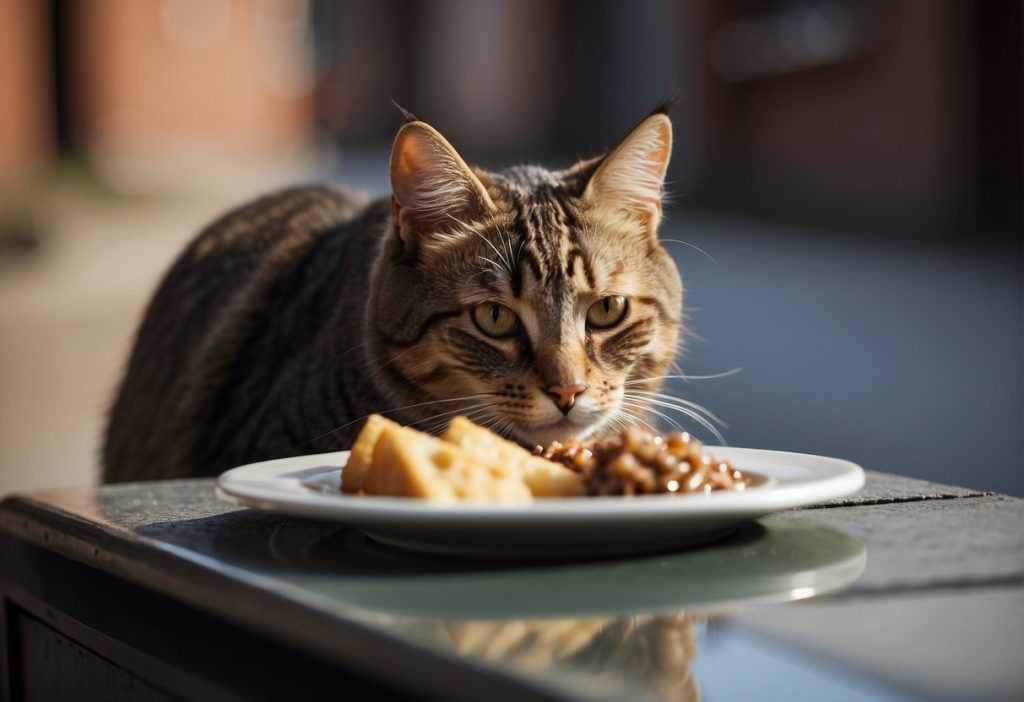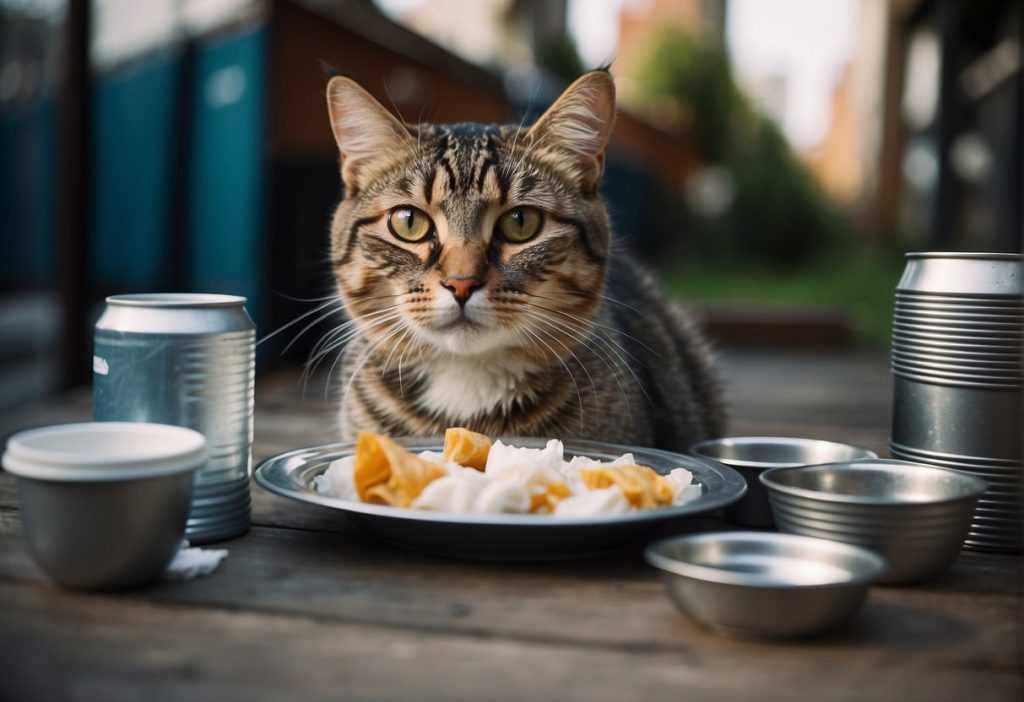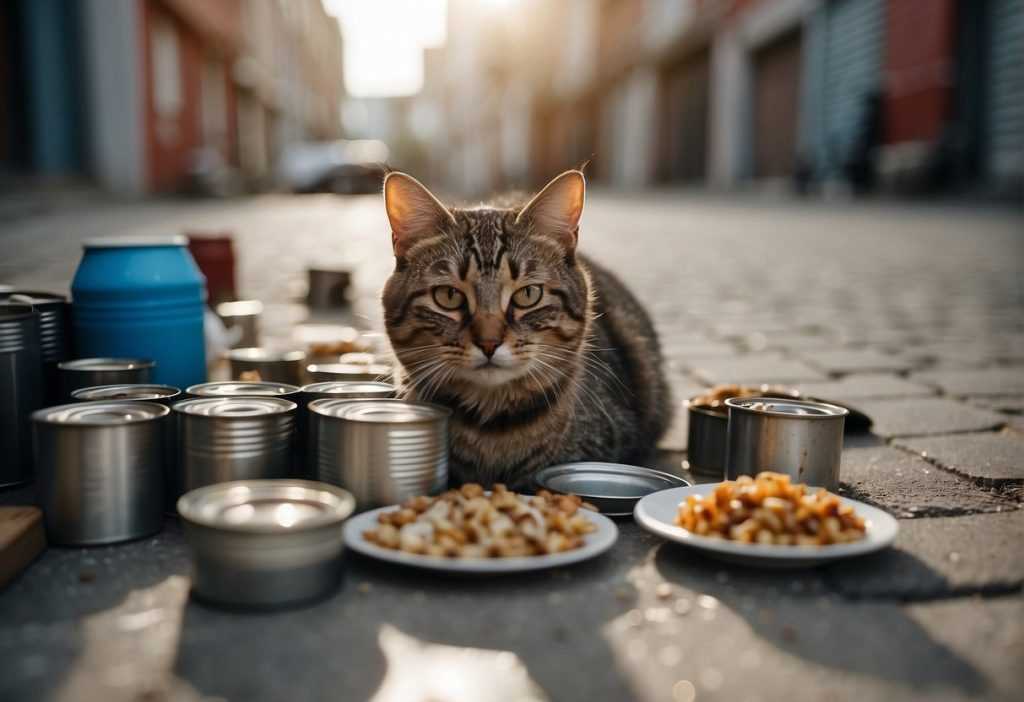Have you ever stumbled upon a hungry stray cat in your neighborhood and wondered what you could offer it to eat, especially when you’re fresh out of cat food?
It happens more than you’d think, and knowing how to feed these feline wanderers without upsetting their tummies is quite important.
After all, while a stray cat’s independent, they still rely on the kindness of humans for sustenance when times get tough.
Picking up uneaten food, including alternative solutions, not only prevents stray cats from accidentally ingesting spoiled food, but it can also deter wildlife and/or bugs from getting to the food.

You might be tempted to share your dinner, but it’s crucial to understand that not all human food is safe for cats.
Stray cats have specific dietary needs which lean heavily towards protein from animal sources.
Immediate feeding solutions could include plain food, such as cooked meats like chicken or turkey, and even a bit of tuna can be a treat.
Just make sure these are free of any sauces or seasonings that could be harmful. Keep in mind, though, if you start feeding a stray, they might just appoint you as their chef!
Key Takeaways
- Safe immediate food options for stray cats include plain, cooked meats such as chicken or turkey and some fish like tuna.
- Avoid feeding stray harmful human foods, and opt for animal-based proteins which are necessary for their diet.
- Consulting a vet for health considerations and establishing long-term feeding strategies helps maintain the stray’s health.
Understanding Stray Cat Nutrition

Let’s tackle the basics of stray cat nutrition—no fluff, just the good stuff. Stray cats might seem like rugged survivors, but their dining habits are more gourmet than you’d guess!
What’s on the menu?
Unlike your pampered home kitty, strays haven’t always had the luxury of balanced meals. They often depend on what they catch or find, possibly leading to deficiencies.
Studies indicate that strays commonly lack taurine, an essential amino acid found in animal protein. (1)
Here’s a quick bite of wisdom: Cats are obligate carnivores.
Yep, just like their big cat cousins in the wild, these little prowlers thrive on meat. We’re talking protein from animal sources like:
- Turkey
- Chicken
- Beef
- And, yes, Fish (Tuna, to be precise!)
But hold on, are strays the same as your home buddy? Not quite. Stray cats might need an extra punch of nutrients to catch up on any missing meals.
Think of them like the outdoor adventurer who’s missed a few picnics.
- Don’t go nuts with nuts: Cats don’t process plant proteins well.
- Lean meats: A ticket to a happy, healthy belly.
Veterinarian insights?
They’ll tell you stray cats benefit immensely from a balanced diet, packing all the needed vitamins and minerals.
Not every stray will sport a Ph.D. in nutrition, but with your help, they can eat like the kings and queens of the concrete jungle!
Remember, while giving a little help to a stray can be heartwarming, it’s important to approach feeding with knowledge and care.
If in doubt, a quick chat with your local vet or a feline nutritionist from Alley Cat Allies, an organization dedicated to protecting and improving the lives of ALL cats, can steer you in the right direction. (2)
Now go forth and be that cat’s hero!
What to feed a stray cat if you don’t have cat food?
Have you just spotted a stray cat in your garden and it looks hungry, but, oh no, you’re out of cat food?
No worries—you’ve got more options than you might think right in your kitchen.
Suitable Household Foods:
- Cooked Chicken: A stray cat in need can certainly benefit from some bite-sized, boneless cooked chicken. (Remove all bones to avoid choking hazards). (3)
- Scrambled Eggs: Extra protein punch! Scrambled eggs—plain, please—are a safe bet. (4)
- Tuna: Cats famously love fish, and tuna in water can be an occasional treat. (5)
Are you feeling a bit like a chef? Let’s whip up a simple Homemade Cat Food Recipe:
- 100g cooked chicken (shredded)
- 50g cooked carrot (mashed)
- A spoonful of cooked pumpkin (mashed)
- Mix all the ingredients and serve it at room temperature.
Now, while it’s okay to help a hungry kitty with these immediate solutions, it’s best to introduce any new foods gradually.
Cats have delicate tummies, and we wouldn’t want to upset them. If you’re planning to feed them regularly, start mixing these homemade meals with regular cat food that high in fiber and nutrition over time.. (6)
Remember, for every busy bee like you who can’t make a run to the pet store at a moment’s notice, “purr-haps” these tips will save the day.
Keep it simple, watch out for your new pet feline friend’s reaction to different foods, and whenever possible, try to lead them towards a steady diet suitable for their needs, even when you’re out of cat food.
Foods to Avoid

Cats are curious by nature but not the best judges of what’s safe to eat.
Here’s a little “no-go” grocery list for you:
- Chocolate: Just like for dogs, it’s a big no-no for cats. (7)
- Onions and Garlic: A side dish of these can lead to anemia. (8)
- Alcohol: Even tiny amounts can be dangerous.
- Caffeinated Drinks: Say “paws off” to your coffee or tea.
- Dairy Products: They’re not the cat’s meow for adult cats, despite popular belief.
- Raw Meat and Eggs: These can sometimes harbor bacteria like Salmonella.
- Grapes and Raisins: These seemingly innocent snacks can cause kidney issues.
Remember, when you’re trying to help, knowledge is power—and power is protecting our feline friends from these hidden hazards.
| Unsafe Food | Why It’s Bad | Safer Alternatives |
| Chocolate | Causes theobromine poisoning | — |
| Onions/Garlic | Damages red blood cells, leading to anemia | Fully cooked meats (plain) |
| Alcohol | Toxic, even in small quantities | — |
| Caffeine | Can cause restlessness, rapid breathing | Fresh water |
| Dairy Products | Adult cats are often lactose intolerant | Specially formulated milk for cats |
| Raw Meat and Eggs | Risk of bacteria such as Salmonella | Cooked lean meats |
| Grapes and Raisins | Can cause kidney damage | — |
Have you heard the story of Whiskers who got into the garlic dip? The poor guy landed in a heap of trouble health-wise. Cats like him rely on your know-how to keep their nine lives intact!
Before reaching for a snack to share, refer back to this quick-check guide. Keeping it handy ensures you’re doing the best for your furry alley acquaintances.
Stay savvy, stay safe, and keep those tails wagging—safety first, right?
Long-Term Feeding Strategies

First Two Weeks: Begin by mixing a bit of regular cat food with whatever temporary food you’ve been giving the stray – something like tuna or scrambled eggs.
Gradually increase the proportion of cat food as the days pass.
Month One: By now, you should aim to have your kitty exclusively on commercial cat food. This shift ensures they’re getting all the necessary nutrients without the unpredictability of scraps.
| Food Type | Cost | Nutritional Value |
| Homemade | Lower | Varies, often unbalanced |
| Commercial | Higher | Formulated for complete diet |
Commercial vs. Homemade: Sure, dishing out chicken bits might be lighter on your wallet, but is it packed with all the needed vitamins and minerals?
Commercial cat food is pricier but specifically crafted to provide a balanced diet – quite a bang for your buck nutrition-wise!
Now, about Fluffy (just a case study cat – you can name yours whatever you like!). Fluffy was once a wary alleywalker.
With patience and a gradual feeding strategy, her guardians switched her entirely to commercial food within six weeks. And would you look at that? Her coat’s now as glossy as a brand-new penny!
On this blog, The Fluffy Kitty, learn how to travel safely and responsibly with your adventure cat while living a more eco-conscious lifestyle.
Remember, consistency is key! With a steady diet and the loving routine you provide, what was once a stray will blossom into a purring, healthy companion. Isn’t that a treat for both of you?
Feeding Practices for Stray Cats
Surprisingly, your kitchen likely holds plenty of safe, stray-cat-friendly foods. Cooked lean meats like chicken or turkey are terrific — just make sure they’re free from bones and seasonings.
Over in the veggie drawer, cooked carrots or broccoli can offer a fiber boost, and let’s not forget the universal breakfast fav: scrambled eggs!
Additionally, fruits like bananas and blueberries, cantaloupe, watermelon (seedless), peeled apples (deseeded), and pumpkins can all be offered as a tasty snack.
Sounds simple enough, right? But portion control is key! Too much of a good thing can lead to an upset stomach.
Aim to feed adult strays about 1/2 cup of food per meal, twice a day. For kittens, a tad less since their tummies are tiny.
Let’s Keep It Clean: Remember to tidy up afterward to keep the feeding spot squeaky clean and avoid attracting unwelcome pests or spreading diseases.
This also means using clean bowls or even a piece of newspaper as a makeshift plate.
Heard about the folks over on Maple Street?
They started a community cat program, each neighbor taking turns providing meals and fresh water. They’ve even built little weather-proof shelters!
Their Facebook page is chock-full of heartwarming stories and could use another tale of kindness — maybe yours?
Feeding Schedule
| Meal | Adult Portion | Kitten Portion |
| Morning | 1/2 cup | 1/4 cup |
| Evening | 1/2 cup | 1/4 cup |
Keep those furry friends fed, and who knows? You might just make a new, four-legged pal on your daily walks.
Health Considerations and Veterinary Advice
Malnutrition can manifest as a noticeable weight loss or a less robust coat, while parasites might mean you spot the little critter itching more than usual or notice changes in its fur texture.
So, how can you tell if these feline wanderers need a vet’s attention? Simple signs include:
- Weight Loss: A stray that feels more bones than fluff may need help.
- Coat Issues: Patchiness or roughness is a cry for care.
- Behavior: A cat that’s less playful or seems lethargic might not be just tired.
When you’re unsure, it’s always wise to err on the side of caution. A quick chat with a vet can set a course for prevention or treatment that could very well save a life.
Remember, annual veterinarian visits are not just for pets; they matter for strays too.
Ever listened to a seasoned cat rescuer share stories?
They’ll likely emphasize the transformative power of veterinary care. Imagine a scrawny, scared kitty turning into a vibrant, affectionate companion! That’s the magic vets can do — with your help in spotting the signs.
Here’s a quick table to help you get a hang of it:
| Health Issue | Signs to Watch Out For | Next Steps |
| Malnutrition | Visible ribs, low energy | Veterinary checkup |
| Parasites | Excessive scratching, bald patches | Parasite treatment |
| General Unwellness | Lethargy or aggression, avoiding food or water | Immediate vet consultation |
Remember, you’re not alone in the quest to help these little nomads. A vet’s guidance is priceless – they’re the unsung heroes in a stray’s tale of survival and happiness!
Quick Recap

When you encounter a stray cat, your kindness can be a beacon of hope in its uncertain world. Remember, while meat is their primary need, stray cats can benefit from a variety of foods.
Think about boiled chicken, turkey, and plain rice or scrambled eggs; these are all savory treats that can appeal to a kitty’s palate.
Feeding strays is more than just a kind gesture; it’s a community effort. By uniting with neighbors and local programs, you can provide not just food but essential veterinary care.
This isn’t just about filling tummies; it’s about promoting health and well-being for our feline friends.
Don’t just walk by; be proactive. Look for signs that indicate if a cat is truly a stray and assess its health.
Community initiatives often provide support and guidance, and they welcome the extra pair of hands. A little bit of your time can make a massive difference!
Here’s a quick rundown of what we’ve covered:
- Stray cats thrive mostly on meat, but certain veggies and grains are safe, too.
- Don’t feed them milk, dog food, or harmful human foods like chocolate or onions, cause dog food and cat food have nutritional differences.
- An adult stray typically needs about 5.5 ounces of canned food and 2 ounces of dry food per day, but this can vary.
Shall we band together and make our streets a warmer place for the strays? Every effort counts, and you have the power to spark change. Ready to make a difference?
Frequently Asked Questions

When it comes to feeding a stray cat without cat food, you might have some questions about what’s safe and what’s not. Don’t worry, I’ve got you covered with the answers you’re looking for!
What safe human foods can I offer to a stray cat?
Absolutely! Cats can enjoy various human foods that are packed with protein. For a purr-fect meal option, consider offering cooked turkey, chicken, or scrambled eggs.
Just remember to skip the seasoning and onions, as these can be harmful to kitty’s health.
Are there any budget-friendly options for feeding a stray cat?
Yes, you can be economical and still provide for a feline friend. Canned fish like salmon or mackerel can be a cost-effective choice – just ensure it’s packed in water and contains no added salt.
Similarly, plain rice can be mixed with meat to stretch out a meal without breaking the bank.
Is it safe to give a stray cat dog food in a pinch?
Not the best idea. While a bite of dog food here and there won’t harm a cat, it’s not suitable for their long-term nutrition.
Cats require specific nutrients like taurine, which dog food lacks. So, it’s important to find cat-specific food for their overall well-being.
Can I feed milk to a stray cat?
It’s a common misconception, but the majority of cats are actually lactose intolerant. While they might lap it up with gusto, milk can lead to digestive issues.
It’s best to provide water as the main drink and skip the dairy aisle.
Is canned tuna safe for stray cats?
In moderation, canned tuna can be a treat for stray cats.
However, it shouldn’t be a regular menu item due to the lack of essential nutrients and the risk of mercury poisoning.
If you’re using tuna, make it an occasional indulgence rather than a staple.
- The Ultimate Overview to Actual Cash Gambling Establishments - July 1, 2025


